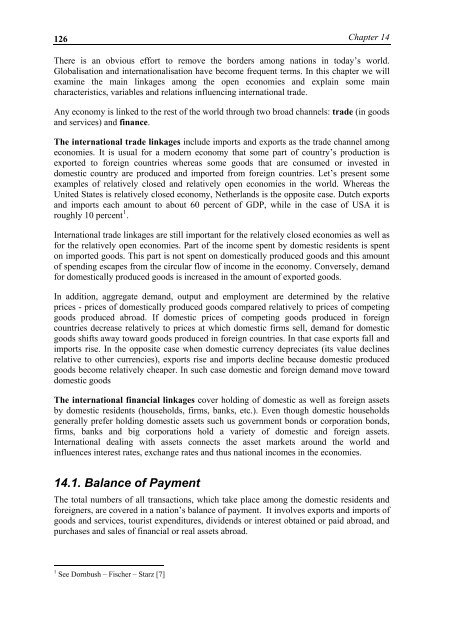MacroeconomicsI_working_version (1)
You also want an ePaper? Increase the reach of your titles
YUMPU automatically turns print PDFs into web optimized ePapers that Google loves.
126<br />
Chapter 14<br />
There is an obvious effort to remove the borders among nations in today’s world.<br />
Globalisation and internationalisation have become frequent terms. In this chapter we will<br />
examine the main linkages among the open economies and explain some main<br />
characteristics, variables and relations influencing international trade.<br />
Any economy is linked to the rest of the world through two broad channels: trade (in goods<br />
and services) and finance.<br />
The international trade linkages include imports and exports as the trade channel among<br />
economies. It is usual for a modern economy that some part of country’s production is<br />
exported to foreign countries whereas some goods that are consumed or invested in<br />
domestic country are produced and imported from foreign countries. Let’s present some<br />
examples of relatively closed and relatively open economies in the world. Whereas the<br />
United States is relatively closed economy, Netherlands is the opposite case. Dutch exports<br />
and imports each amount to about 60 percent of GDP, while in the case of USA it is<br />
roughly 10 percent 1 .<br />
International trade linkages are still important for the relatively closed economies as well as<br />
for the relatively open economies. Part of the income spent by domestic residents is spent<br />
on imported goods. This part is not spent on domestically produced goods and this amount<br />
of spending escapes from the circular flow of income in the economy. Conversely, demand<br />
for domestically produced goods is increased in the amount of exported goods.<br />
In addition, aggregate demand, output and employment are determined by the relative<br />
prices - prices of domestically produced goods compared relatively to prices of competing<br />
goods produced abroad. If domestic prices of competing goods produced in foreign<br />
countries decrease relatively to prices at which domestic firms sell, demand for domestic<br />
goods shifts away toward goods produced in foreign countries. In that case exports fall and<br />
imports rise. In the opposite case when domestic currency depreciates (its value declines<br />
relative to other currencies), exports rise and imports decline because domestic produced<br />
goods become relatively cheaper. In such case domestic and foreign demand move toward<br />
domestic goods<br />
The international financial linkages cover holding of domestic as well as foreign assets<br />
by domestic residents (households, firms, banks, etc.). Even though domestic households<br />
generally prefer holding domestic assets such us government bonds or corporation bonds,<br />
firms, banks and big corporations hold a variety of domestic and foreign assets.<br />
International dealing with assets connects the asset markets around the world and<br />
influences interest rates, exchange rates and thus national incomes in the economies.<br />
14.1. Balance of Payment<br />
The total numbers of all transactions, which take place among the domestic residents and<br />
foreigners, are covered in a nation’s balance of payment. It involves exports and imports of<br />
goods and services, tourist expenditures, dividends or interest obtained or paid abroad, and<br />
purchases and sales of financial or real assets abroad.<br />
1 See Dornbush – Fischer – Starz [7]




